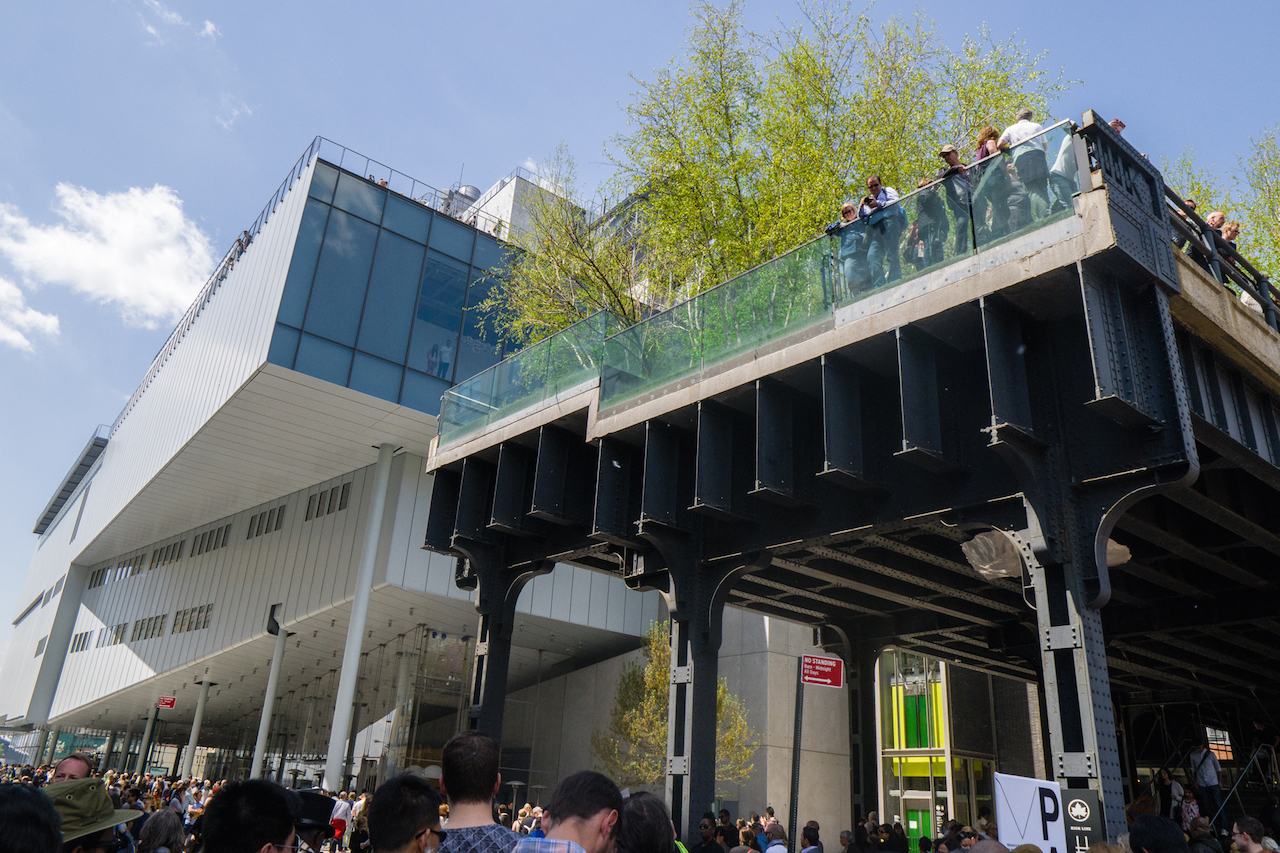
opening weekend in May, above. Architect Renzo Piano has described the new building’s design as defying gravity. File photo by Milo Hess
BY MICHELE HERMAN | Some of the people I am closest to revere visual art. One goes so far as to call museumgoing a religion. I am not that devoted.
At museum events I sometimes chafe at the self-congratulatory tone, the rarefied atmosphere and the unquestioned practice of wining and dining the last people on the planet who need a free meal.
So I felt ambivalent about the arrival of the new Whitney three blocks from my door, as I felt ambivalent about the old Whitney on Madison Ave. I could talk the art-cognoscenti talk and profess my undying affection for the “Breuer building” — but in fact I’ve always felt it was leering at me while threatening to squash me.
But the new Whitney, three blocks from my apartment, has been growing on me.
This is the pullout quotation at the beginning of the gargantuan Frank Stella retrospective that’s up through Feb. 7: “The more paintings you make, the more you learn.” My first reaction, when my husband and I moseyed over there on a recent Sunday, was “duh.” But then I thought some more, and I grew impressed and maybe a little enchanted. What an interesting sentence, its every word leading up to learning. And how telling that the curators chose to lead their exhibit with it. No one was showcasing that elusive and sometimes pretentious thing called vision, or showing off their erudition, or shaming others with more modest ambitions.
The new Whitney building stands at the epicenter of moneyed Manhattan hipness and tries mightily, as architect Renzo Piano has said, to defy gravity. But I’m finding the institution surprisingly down to earth.
The staff seem to understand that a lot of people feel far less welcome in museums than I ever will, and are doing their damnedest to break down the walls between the insiders and the outsiders. Piano’s building does this literally with huge expanses of glass on three sides of the museum. The administration has also done it by making the ground floor free and open to the public, stocking the entire building with comfy leather furniture, and taking pains to be inclusive in its curating.
The always-charming Piano has said that American art can be a little impolite, so he made a building that’s a little impolite, too. But I think the Piano building has exemplary manners, if manners involve making people feel at home — not just the seating, but the terraces, the stairwells with their shock of sunlight and Hudson River views; the reclaimed pickled oak floors (from a bra factory in Pennsyslvania); the layout that guides visitors gracefully through the galleries and is never confusing like the Museum of Modern Art; and glass doors onto the staff spaces that break down the usual barriers and create even more unexpected views.
I’ve been working my way slowly from the building’s top to the bottom, getting to know the pieces on display from the Whitney’s huge permanent collection. The gang’s all there — Hopper, Calder, O’Keeffe. But I have found myself drawn to works by some of the more obscure artists, such as a pair of delicate drawings by a man named James Castle. I chuckled when I read that his medium was “soot and saliva on found board.”
In a small screening room I grew transfixed by trippy cartoons made of simple Colorform-like shapes set to classical music by Mary Ellen Bute in the late ’30s.
One large and rather threatening piece spoke to me unexpectedly. It’s an untitled work from 1961 by a woman named Lee Bontecou, a big square framed relief full of rapacious maws with sharp metal teeth coming at the viewer, as if a couple of de Kooning’s women had sprung forth into 3-D. I thought it was scary and beautiful and hilarious in equal parts. How can it be, I thought, that Bontecou is not a household name? Curiously, the wall label again revealed an unusual (not to mention inexpensive) working method: It’s made of fabric stretched over conveyor belts taken from the laundry under her studio.
As for Frank Stella, I’ve always marveled at and kind of feared the enormous confidence it must take to make a painting as big as a lap pool and sculptures that bolt to multiple points on the gallery wall, require whole staffs of assistants, and stick out yards in every direction. But I came away from the museum’s new Stella show understanding and respecting his ambition, both his seriousness and his playfulness in pushing painting beyond what felt to him like the straitjacket of a square frame.
It turns out that the huge colorful curlicue metal sculptures I always associated with Stella barely began to define him, and that the Whitney’s floor-through gallery is the only possible venue that can do justice to the mad variety of his output.
I always assumed my occasional balkiness in an art museum was a failing on my part. But lately I’ve begun considering the possibility that I could have been reacting to actual forces at work in some museums’ exhibits. Maybe the work was more provocative than rigorous; maybe it was thumbing its nose at society but catching me in the same net; maybe the exhibit was poorly curated or the wall labels dull and pedantic.
Like most people, I’ve never had an art museum in my immediate neighborhood before, but I’m starting to get the hang of it. Several times lately, I’ve moseyed over to the Whitney with nothing in my pocket besides my keys and my membership card. If I feel like it, I can stop in to see just one painting.
I love the way the Whitney curators are using their vast new galleries to wedge open all this new space in the canon. Turns out the canon is a much more fluid, colorful and eccentric place than we’d been led to believe.
Who knows, maybe I’ll reach religious fervor.

















